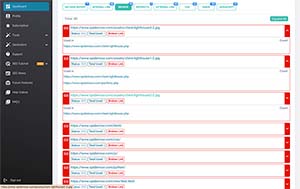Efficiently detecting and fixing broken links
Maintaining a seamless user experience and preserving strong search engine rankings

Broken links and how it can harm your site's SEO
In today's digital age, websites play a pivotal role in disseminating information, promoting businesses, and connecting with audiences across the globe. A well-maintained website is crucial for establishing a strong online presence. However, websites are not static; they evolve and change over time. As a result, links on a website can become broken, leading to a subpar user experience and negative SEO implications.Before we delve into the methods for finding broken links, it's essential to understand why they matter. Broken links, also known as dead links or 404 errors, occur when a hyperlink points to a URL that no longer exists or is inaccessible. These links can be detrimental for several reasons:
User Experience: Broken links frustrate website visitors, disrupting their navigation and reducing their trust in the site. This poor user experience can lead to higher bounce rates and decreased user engagement.
SEO Impact: Search engines like Google penalize websites with broken links. They interpret these errors as a lack of maintenance and relevance, which can negatively affect a site's search engine rankings.
Crawl Efficiency: Search engine bots use links to navigate and index web content. Broken links can hinder the efficient crawling and indexing of a website, potentially leading to missed opportunities for ranking in search results.
Lost Opportunities: Broken links can lead to missed opportunities for conversions. A user who encounters a broken link while attempting to make a purchase or access valuable content may abandon the site.
Given these consequences, it's crucial to regularly check for broken links and address them promptly to maintain a healthy website.
One of the simplest ways to find broken links is through manual inspection. Navigate through your website, clicking on each link to ensure they are functioning correctly. While this method is feasible for small websites, it can be extremely time-consuming for larger, more complex ones.
Numerous online tools and services are available that can automate the process of finding broken links. These tools crawl your website and identify broken links, providing you with a detailed report. Some popular options include Broken Link Check, W3C Link Checker, and SpiderNow SEO Spider.
Google Search Console is a valuable tool for website owners. It not only provides insights into your website's performance but also alerts you to any crawl errors, including broken links. Regularly checking your Google Search Console account can help you stay on top of broken link issues.
If you use a CMS like WordPress, there are several plugins available that can automatically find and notify you of broken links. Examples include the Broken Link Checker plugin for WordPress and the Dr. Link Check plugin for Drupal.
For advanced users, custom scripts and programming can be employed to find broken links. You can write scripts in languages like Python or JavaScript to scan your website for broken links and generate reports.
Now that you have identified the broken links on your website, it's essential to address them effectively. Here are some strategies for maintaining a healthy website:
Not all broken links are of equal importance. Prioritize fixing links that are crucial for user experience and lead to essential pages. Organize your list of broken links based on their significance and impact on your website.
If a broken link was pointing to a valuable page that has been moved or deleted, consider implementing a 301 redirect. This permanent redirect will send users and search engines to a new, relevant URL, preserving both user experience and SEO rankings.
Make sure all internal links are pointing to the correct pages within your website. If you've restructured your site or changed URLs, update internal links accordingly.
If a broken link is pointing to an external website, consider reaching out to the website owner and suggesting an alternative link. This can help improve the user experience on your site and potentially lead to valuable backlinks.
Broken links can reappear over time as websites change and evolve. Therefore, it's essential to make regular link checking a part of your website maintenance routine. Set up automated checks at intervals that suit your website's update frequency.
Keep an eye on your website's 404 error pages. Customize these pages to provide helpful information and navigation options for users who encounter broken links.
If you have a team responsible for website content and updates, educate them about the importance of avoiding broken links and provide guidelines for link maintenance.
In conclusion, broken links can have detrimental effects on a website's user experience, SEO performance, and overall functionality. Detecting and addressing broken links is a crucial aspect of website maintenance. Whether you choose to use online tools, manual checks, or a combination of methods, regularly finding and fixing broken links should be an integral part of your website management strategy. By prioritizing, organizing, and implementing effective solutions, you can ensure that your website remains reliable, user-friendly, and optimized for search engines. Remember, a healthy website is a key component of online success in today's digital landscape.
The above information is a brief explanation of this technique. To learn more about how we can help your company improve its rankings in the SERPs, contact our team below.

Bryan Williamson
Web Developer & Digital Marketer

Web Developer & Digital Marketer
Digital Marketer and Web Developer focusing on Technical SEO and Website Audits. I spent the past 26 years of my life improving my skillset primarily in Organic SEO and enjoy coming up with new innovative ideas for the industry.













